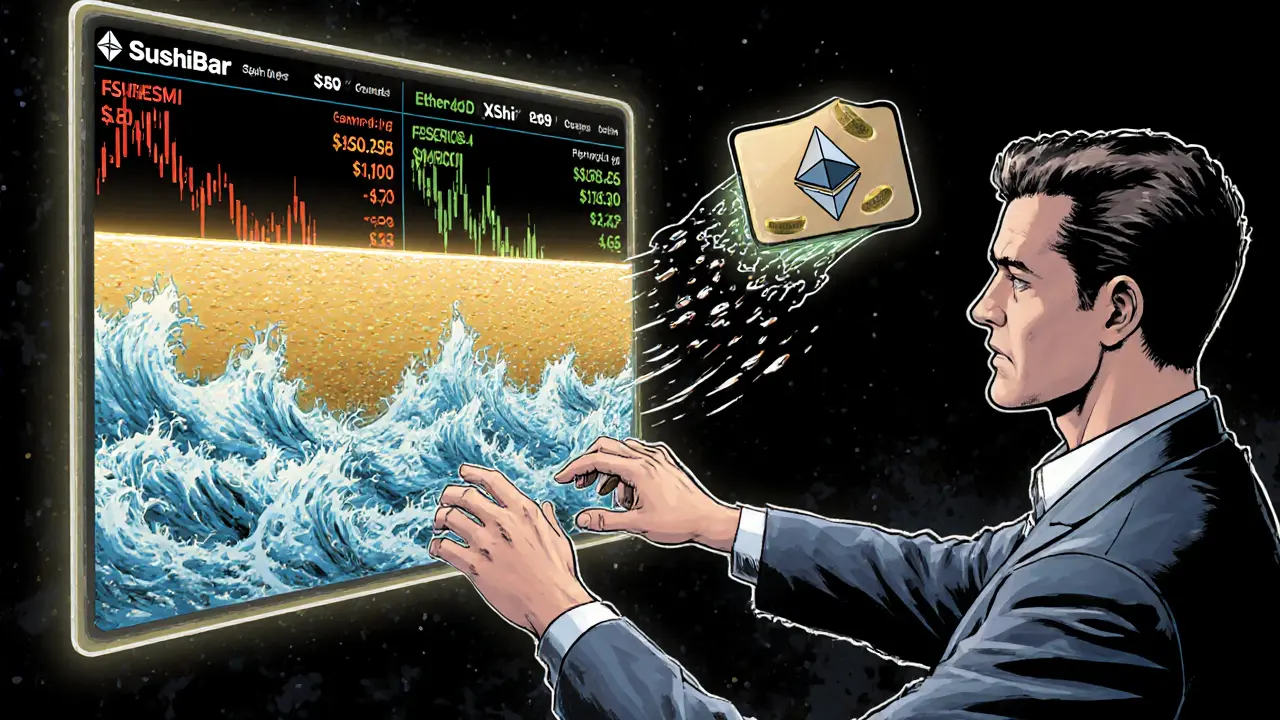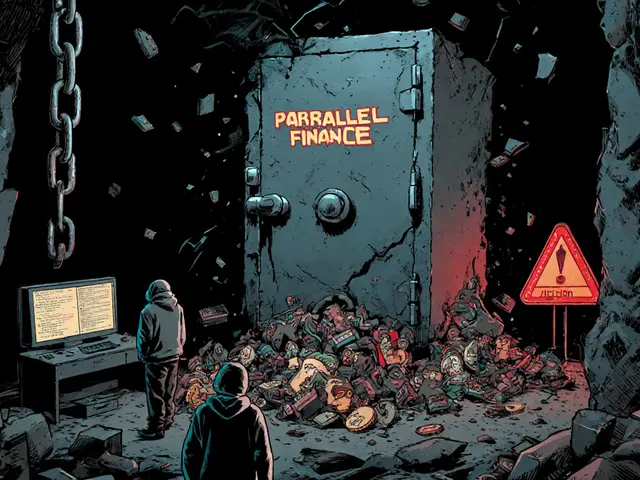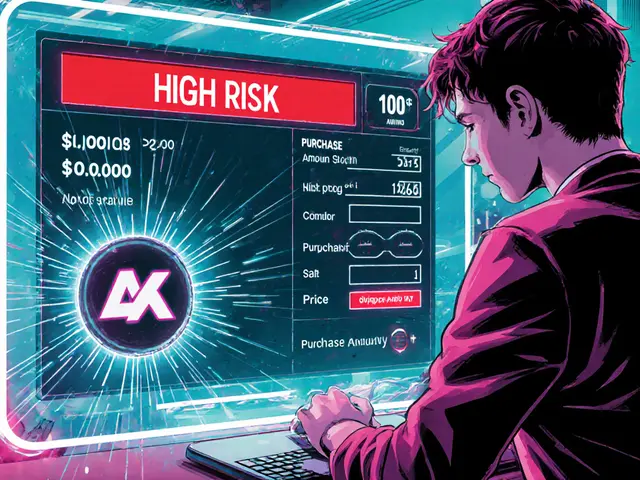SushiSwap V3 (Core) Crypto Exchange Review: Fees, Rewards, and Real Performance in 2025
SushiSwap V3 Liquidity Rewards Calculator
Liquidity Provider Calculator
Most crypto traders think decentralized exchanges are either too complicated or not worth the hassle. But SushiSwap V3 (Core) isn’t like the others. It’s not just another Uniswap clone with a new logo. By October 2025, it’s locked up nearly $4 billion in assets and moved over $69 billion in trades - numbers that put it in the same league as some centralized exchanges. If you’re tired of paying high fees on Coinbase or Binance and want to earn rewards just for using the platform, SushiSwap V3 might be the switch you’ve been waiting for.
How SushiSwap V3 Works - No Middlemen, Just Code
SushiSwap V3 runs on Ethereum and Polygon, meaning you don’t need a bank or broker to trade. Instead, it uses something called an Automated Market Maker (AMM). That means trades happen directly between users and smart contracts, not people. Liquidity providers - users who deposit crypto into pools - supply the assets, and the protocol automatically sets prices based on supply and demand. No order books. No market makers. Just math.
The big upgrade from V2 to V3? Concentrated liquidity. In V2, your funds were spread evenly across all price ranges. In V3, you pick exactly where you want your liquidity to be active - like setting a price range for a limit order. If the price stays within that range, you earn more fees. If it moves outside, your funds stop earning until it comes back. It’s like trading options: higher potential returns, but more risk if you get the range wrong.
Fees and Rewards: You Get Paid Just for Using It
Every trade on SushiSwap costs 0.3% in fees. That’s standard. But here’s where it gets interesting: that fee isn’t just going to the liquidity providers. SushiSwap splits it. 0.25% goes to the people who put up the crypto. The other 0.05% goes to holders of xSUSHI - the staked version of the SUSHI token.
That’s a big deal. Most DEXs give all fees to liquidity providers. SushiSwap makes you earn twice: once by providing liquidity, and again by holding SUSHI. You convert your SUSHI to xSUSHI through the SushiBar, and you start getting a share of every trade on the platform. As of October 2025, the SUSHI token trades at $0.6881, and staking it gives you ongoing passive income without locking your funds for years.
There’s also the Onsen Program. If you add liquidity to a new token listed on SushiSwap, you get bonus SUSHI rewards on top of the regular trading fees. It’s a smart way to encourage early support for new projects - and it’s why many DeFi users still choose SushiSwap over Uniswap, even though Uniswap has more tokens.
What You Can Trade - And What You Can’t
SushiSwap V3 currently supports 3 core cryptocurrencies across 5 trading pairs. That’s not a lot compared to centralized exchanges that list thousands. If you’re looking to trade obscure altcoins, you won’t find them here. But if you’re trading ETH, USDC, or WBTC - the big, liquid assets - you’re covered. And because those are the most traded pairs, the spreads are tight. The average bid-ask spread is just 0.634%, which is better than many centralized exchanges charge for the same pairs.
There’s no margin trading. No leverage. No derivatives. That’s intentional. SushiSwap is focused on being a simple, secure spot trading platform. If you want to gamble with 10x leverage, go to a centralized exchange. If you want to trade crypto without handing over your keys, SushiSwap is built for that.

Wallets, Gas, and Getting Started
You need a crypto wallet to use SushiSwap. It supports six: MetaMask, Coinbase Wallet, WalletConnect, Rainbow, Argent, and OKX Wallet. That’s plenty. Connect one, pick your token pair, and swap. It’s that simple for basic trades.
But here’s the catch: Ethereum gas fees. If you’re doing small trades under $50, you might end up paying more in gas than the trade is worth. That’s why many users switch to the Polygon version of SushiSwap. It’s faster, cheaper, and still fully functional. You can swap, stake, farm, and govern on Polygon with near-zero fees. If you’re new, start there.
Fiat deposits? Yes, but only through third-party partners. You can buy crypto with bank transfers or Apple Pay, then send it to your wallet. SushiSwap doesn’t handle fiat directly - which keeps it decentralized. But it does make the on-ramp easier than it was two years ago.
Limit Orders and DCA: The New Tools for Smarter Traders
In July 2025, SushiSwap launched two major upgrades: Limit Orders and Dollar Cost Averaging (DCA). These weren’t just features - they were game-changers.
Limit Orders let you set a price to buy or sell crypto, even if you’re offline. If ETH hits $3,200, your order executes automatically. No more refreshing the screen. DCA lets you schedule recurring buys - say, $50 of BTC every Monday. It’s the same tool big investors use to avoid timing the market. These features used to be exclusive to centralized exchanges. Now they’re live on a decentralized platform.
These updates show SushiSwap isn’t resting. It’s adapting. And that matters. In DeFi, platforms that stop evolving die fast.

Security, Risks, and What Users Are Saying
SushiSwap has never been hacked. The code has been audited multiple times. But that doesn’t mean it’s risk-free. The biggest danger? You. If you send crypto to the wrong address. If you approve a malicious token. If you don’t understand concentrated liquidity and your funds get stuck outside your price range. These aren’t platform flaws - they’re user errors.
Users report that the interface is clean and beginner-friendly, especially on Polygon. But the learning curve spikes when you try advanced features. One trader said, “I lost $120 because I set my liquidity range too narrow. I didn’t realize how fast ETH moves.” That’s the trade-off: higher rewards come with more responsibility.
There’s no demo account. No paper trading. You’re putting real money in from day one. That’s a problem for new users. But Sushi Academy helps. It’s a free, non-profit learning hub with guides on everything from connecting wallets to understanding impermanent loss. It’s not perfect, but it’s one of the few DeFi platforms that actually tries to educate its users.
SushiSwap vs. Uniswap: Who Wins?
Uniswap has more tokens. More users. More liquidity. But SushiSwap has something Uniswap doesn’t: a built-in reward system for token holders.
Uniswap gives 100% of fees to liquidity providers. SushiSwap gives 83% to providers and 17% to stakers. That 17% might seem small, but with $69 billion in volume, that’s over $11 million in annual rewards going to xSUSHI holders. That’s real money. And it creates loyalty. People don’t just use SushiSwap to trade - they use it because they own part of it.
Uniswap is the default. SushiSwap is the upgrade.
Is SushiSwap V3 Right for You?
If you’re a beginner and just want to swap ETH for USDC without paying $15 in fees, SushiSwap on Polygon is perfect. It’s cheap, fast, and simple.
If you’re an active trader who wants to earn passive income while you trade, the xSUSHI staking and Onsen rewards make it one of the best options in DeFi.
If you want to trade obscure tokens or use leverage, look elsewhere.
If you’re scared of smart contracts, maybe wait until you’ve used a wallet before. But if you’re ready to take control of your crypto and get paid for it, SushiSwap V3 isn’t just an option - it’s one of the most rewarding ones left in DeFi.
Does SushiSwap V3 support fiat deposits?
SushiSwap doesn’t accept fiat directly. But it integrates with third-party services that let you buy crypto using bank transfers, Apple Pay, or debit cards. You buy the crypto on those platforms, send it to your wallet, then connect that wallet to SushiSwap to trade.
What’s the difference between SUSHI and xSUSHI?
SUSHI is the native token of SushiSwap. xSUSHI is what you get when you stake your SUSHI in the SushiBar. When you stake, your SUSHI is locked and converted to xSUSHI, which gives you a share of platform fees and voting power. You can unstake anytime, but you’ll get back SUSHI, not xSUSHI.
Is SushiSwap safer than centralized exchanges?
It’s safer in one way: you keep control of your keys. No one can freeze your account or steal your funds by hacking a central server. But it’s riskier in another: if you make a mistake - like approving a bad contract or setting a bad liquidity range - you lose money with no customer support. Centralized exchanges have help desks. SushiSwap has documentation.
Why does SushiSwap have fewer tokens than Uniswap?
SushiSwap focuses on quality over quantity. It prioritizes liquidity and stability for major assets like ETH, USDC, and WBTC. Adding low-liquidity tokens increases risk and dilutes rewards. By limiting pairs, it ensures better trading conditions and higher yields for users who provide liquidity.
Can I use SushiSwap on my phone?
Yes. Use a mobile wallet like MetaMask or Coinbase Wallet. Open the SushiSwap website in your phone’s browser, connect your wallet, and trade. The interface works on mobile, though advanced features like concentrated liquidity are easier to manage on desktop.
What’s the best way to start with SushiSwap V3?
Start on Polygon. Use a small amount of ETH or USDC to swap between two major tokens. Then, try staking a little SUSHI to earn xSUSHI. Once you’re comfortable, explore Limit Orders and DCA. Don’t jump into concentrated liquidity until you understand how price ranges work.






23 Comments
Bruce Bynum
November 1 2025SushiSwap V3 on Polygon is a game changer for small traders. No more paying $10 in gas to swap $20 worth of ETH. I started with $50, swapped to USDC, staked 1 SUSHI, and now I’m earning a few cents every day just for holding. It’s not life-changing money, but it’s passive income with zero effort.
Sammy Krigs
November 1 2025ok so i just tried this and my tx failed 3 times and i think i got scammed bc my wallet is empty now? someone help??
Jeremy Jaramillo
November 2 2025Sammy, you’re not alone. I did the same thing my first week. Didn’t check the approval amount and accidentally approved 1000 SUSHI to some random contract. Lost $87. Learned the hard way: always check the contract address before approving. And never approve more than you’re comfortable losing. There’s a reason people say ‘not your keys, not your crypto’ - it’s because the system doesn’t care if you mess up.
Masechaba Setona
November 3 2025They’re all just pumping this to get you to buy SUSHI so they can dump it later. The ‘rewards’ are a trap. They want you to think you’re earning, but the token’s price is artificially inflated by bots and insiders. You think you’re getting paid? You’re just funding the dev team’s Lambos. And don’t get me started on ‘concentrated liquidity’ - that’s just a fancy way to say ‘you lose everything if the price moves 2%.’
Phyllis Nordquist
November 4 2025While Masechaba raises valid concerns about market manipulation, it’s worth noting that SushiSwap’s fee distribution model is transparently documented on their governance portal. The xSUSHI staking mechanism has been live for over 18 months with no evidence of token dumping by core contributors. The 0.05% fee allocation to stakers is mathematically verifiable on-chain. That said, concentrated liquidity does require education - and that’s why platforms like Sushi Academy exist. It’s not a scam; it’s a learning curve.
Wesley Grimm
November 5 2025Let’s be real - $4B TVL sounds impressive until you realize Uniswap has $18B. And $69B in volume? That’s less than 1% of Coinbase’s monthly volume. The ‘rewards’ are negligible. You’re talking about pennies per day unless you’re staking $100k worth of SUSHI. This isn’t a revolution. It’s a rebrand with a thin veneer of DeFi hype.
Eliane Karp Toledo
November 5 2025What if the entire DeFi model is just a Ponzi scheme disguised as decentralization? Who really owns the smart contracts? Who’s mining the data from all these wallet interactions? They say ‘no middlemen’ - but the middlemen are just code now. And code can be changed. Backdoor in the next update? You think you’re in control? You’re just a data point in a ledger.
Jason Coe
November 6 2025I’ve been using SushiSwap for 14 months now. Started with $200, now I’ve got $1,800 locked in liquidity on Polygon. The DCA feature is what saved me. I set it to buy $25 of ETH every Tuesday. Didn’t time the market once. Even when ETH dropped 30% in December, I kept buying. Now I’m up 120% on that stack. The interface is clunky on mobile, but on desktop? Smooth. And the xSUSHI rewards? I cashed out $412 in rewards last quarter. Not enough to quit my job, but enough to pay for my Netflix and coffee. That’s real.
mark Hayes
November 8 2025just started using sushi on my phone and its actually not bad 😌 got my first reward today and i feel like a crypto wizard now 🤓
Edgerton Trowbridge
November 8 2025For newcomers, I strongly recommend starting with the Polygon network and limiting your initial exposure to under $100. The learning curve for concentrated liquidity is steep, and impermanent loss is a real phenomenon that even seasoned traders underestimate. SushiSwap’s documentation is among the most comprehensive in DeFi, but it requires patience. Treat this as a long-term financial education opportunity, not a get-rich-quick scheme. The rewards compound over time - not instantly.
naveen kumar
November 10 2025They say it’s decentralized but the core devs hold 12% of the token supply. The Onsen program is a front for insider token dumps. The ‘community governance’ votes are rigged. The audit reports are paid for by the foundation. You think you’re choosing freedom? You’re just another node in a controlled system designed to extract value from the naive. The real power lies in the wallets of the early investors - not in the code.
Genevieve Rachal
November 11 2025And yet, you all ignore the fact that SushiSwap’s user retention rate is below 15% after 90 days. Most people come in for the rewards, get scared off by the interface, and leave. The $4B TVL is mostly from yield farmers who jump from platform to platform. This isn’t adoption - it’s speculation dressed up as innovation. The only people winning are the ones who sold their SUSHI at $2.50.
Eli PINEDA
November 12 2025i tried to stake my sushi but i think i clicked the wrong button and now my tokens are gone?? is there a way to undo it??
Brett Benton
November 14 2025Just got back from a trip to Nigeria and saw a guy in Lagos using SushiSwap on his $50 Android phone to earn rewards. No bank. No ID. Just a wallet and a Wi-Fi connection. That’s what this is about. Not the TVL numbers. Not the fee splits. It’s about access. People who’ve never had a bank account now have a way to earn from global markets. That’s not hype. That’s history.
bob marley
November 16 2025Oh wow, another ‘decentralized finance’ article. Next you’ll tell me the blockchain is the future of democracy. Wake up. The entire crypto space is a casino run by billionaires who want you to gamble while they cash out. SushiSwap? Just another slot machine with a fancy name.
Helen Hardman
November 16 2025I’ve been using SushiSwap for over a year now, and I have to say - the Limit Orders feature completely changed how I trade. I used to sit there refreshing my screen for hours, waiting for ETH to hit $3k. Now I set the order, walk away, and come back to it executed. It’s so simple. And the DCA feature? I’ve automated my BTC buys every Friday. It’s the most stress-free way to accumulate. I used to be terrified of DeFi, but now I feel like I finally understand it. SushiSwap didn’t just give me tools - it gave me confidence.
Matthew Affrunti
November 17 2025My buddy lost $300 last month because he thought he could set a 10% price range for ETH-USDC and just chill. Price moved, his liquidity got pulled, he panicked and withdrew at a loss. Then he blamed SushiSwap. Look - this isn’t a game. It’s finance. You have to learn the rules. Read the docs. Watch the videos. The platform isn’t the problem. The mindset is.
Phil Higgins
November 19 2025What we’re seeing here isn’t just a technical upgrade - it’s a philosophical shift. Centralized exchanges commodify trust. SushiSwap commodifies participation. The real value isn’t in the liquidity pools or the fee splits - it’s in the alignment of incentives. When you hold xSUSHI, you’re not just a user. You’re a stakeholder. That’s the core innovation. Everything else - the UI, the pairs, the gas - is just implementation detail.
ISAH Isah
November 21 2025sushiswap is not decentralized if you need to use metamask and connect to website which is controlled by central entity the code may be open but the access is not the real decentralization is when you dont need to trust any server or wallet provider
Kymberley Sant
November 22 2025i thought xsushi was a new coin but its just staked sushi?? so if i unstake i get my sushi back but no rewards??
Eric Redman
November 23 2025Y’all are acting like this is the second coming. SushiSwap V3 is just Uniswap with extra steps and a loyalty card. The ‘rewards’ are barely noticeable unless you’re whale-tier. And don’t get me started on the ‘Onsen’ program - it’s just a way to pump new tokens so the devs can dump them. I’ve seen 3 tokens get listed, spike 300%, then crash 90% in a week. You think you’re helping the ecosystem? You’re just the sucker at the end of the line.
Bhavna Suri
November 25 2025This is too complicated. Why can’t I just use Binance? At least there, if I mess up, I can call customer service. Here? I’m on my own. I don’t want to be a crypto expert. I just want to buy Bitcoin. This is not for me.
Derek Hardman
November 26 2025While the article presents a compelling case for SushiSwap V3, it is worth noting that the platform’s reliance on Ethereum and Polygon introduces systemic risk through network congestion and potential protocol-level vulnerabilities. Moreover, the absence of insurance mechanisms for user losses - unlike some centralized exchanges - remains a material disadvantage for risk-averse participants. The innovation is notable, but the risk profile is non-trivial and should be carefully weighed.